[English] 日本語
 Yorodumi
Yorodumi- PDB-2kif: Solution NMR structure of an O6-methylguanine DNA methyltransfera... -
+ Open data
Open data
- Basic information
Basic information
| Entry | Database: PDB / ID: 2kif | ||||||
|---|---|---|---|---|---|---|---|
| Title | Solution NMR structure of an O6-methylguanine DNA methyltransferase family protein from Vibrio parahaemolyticus. Northeast Structural Genomics Consortium target VpR247. | ||||||
 Components Components | O6-methylguanine-DNA methyltransferase | ||||||
 Keywords Keywords | TRANSFERASE / Methods Development / solution NMR structure / DNA base repair / O6 methylguanine methyltransferase / NESG / PSI-2 / Methyltransferase / Structural Genomics / Protein Structure Initiative / Northeast Structural Genomics Consortium | ||||||
| Function / homology |  Function and homology information Function and homology information | ||||||
| Biological species |  Vibrio parahaemolyticus AQ3810 (bacteria) Vibrio parahaemolyticus AQ3810 (bacteria) | ||||||
| Method | SOLUTION NMR / simulated annealing | ||||||
| Model details | lowest energy, model 1 | ||||||
 Authors Authors | Aramini, J.M. / Belote, R.L. / Ciccosanti, C.T. / Jiang, M. / Rost, B. / Nair, R. / Swapna, G.V.T. / Acton, T.B. / Xiao, R. / Everett, J.K. ...Aramini, J.M. / Belote, R.L. / Ciccosanti, C.T. / Jiang, M. / Rost, B. / Nair, R. / Swapna, G.V.T. / Acton, T.B. / Xiao, R. / Everett, J.K. / Montelione, G.T. / Northeast Structural Genomics Consortium (NESG) | ||||||
 Citation Citation |  Journal: J.Biol.Chem. / Year: 2010 Journal: J.Biol.Chem. / Year: 2010Title: Structural basis of O6-alkylguanine recognition by a bacterial alkyltransferase-like DNA repair protein. Authors: Aramini, J.M. / Tubbs, J.L. / Kanugula, S. / Rossi, P. / Ertekin, A. / Maglaqui, M. / Hamilton, K. / Ciccosanti, C.T. / Jiang, M. / Xiao, R. / Soong, T.T. / Rost, B. / Acton, T.B. / Everett, ...Authors: Aramini, J.M. / Tubbs, J.L. / Kanugula, S. / Rossi, P. / Ertekin, A. / Maglaqui, M. / Hamilton, K. / Ciccosanti, C.T. / Jiang, M. / Xiao, R. / Soong, T.T. / Rost, B. / Acton, T.B. / Everett, J.K. / Pegg, A.E. / Tainer, J.A. / Montelione, G.T. | ||||||
| History |
|
- Structure visualization
Structure visualization
| Structure viewer | Molecule:  Molmil Molmil Jmol/JSmol Jmol/JSmol |
|---|
- Downloads & links
Downloads & links
- Download
Download
| PDBx/mmCIF format |  2kif.cif.gz 2kif.cif.gz | 742.2 KB | Display |  PDBx/mmCIF format PDBx/mmCIF format |
|---|---|---|---|---|
| PDB format |  pdb2kif.ent.gz pdb2kif.ent.gz | 629.4 KB | Display |  PDB format PDB format |
| PDBx/mmJSON format |  2kif.json.gz 2kif.json.gz | Tree view |  PDBx/mmJSON format PDBx/mmJSON format | |
| Others |  Other downloads Other downloads |
-Validation report
| Summary document |  2kif_validation.pdf.gz 2kif_validation.pdf.gz | 338 KB | Display |  wwPDB validaton report wwPDB validaton report |
|---|---|---|---|---|
| Full document |  2kif_full_validation.pdf.gz 2kif_full_validation.pdf.gz | 439.2 KB | Display | |
| Data in XML |  2kif_validation.xml.gz 2kif_validation.xml.gz | 28 KB | Display | |
| Data in CIF |  2kif_validation.cif.gz 2kif_validation.cif.gz | 49.1 KB | Display | |
| Arichive directory |  https://data.pdbj.org/pub/pdb/validation_reports/ki/2kif https://data.pdbj.org/pub/pdb/validation_reports/ki/2kif ftp://data.pdbj.org/pub/pdb/validation_reports/ki/2kif ftp://data.pdbj.org/pub/pdb/validation_reports/ki/2kif | HTTPS FTP |
-Related structure data
| Similar structure data | |
|---|---|
| Other databases |
- Links
Links
- Assembly
Assembly
| Deposited unit | 
| |||||||||
|---|---|---|---|---|---|---|---|---|---|---|
| 1 |
| |||||||||
| NMR ensembles |
|
- Components
Components
| #1: Protein | Mass: 12341.314 Da / Num. of mol.: 1 Source method: isolated from a genetically manipulated source Source: (gene. exp.)  Vibrio parahaemolyticus AQ3810 (bacteria) Vibrio parahaemolyticus AQ3810 (bacteria)Gene: A79_1377, VP0951 / Plasmid: VpR247-21.9 / Production host:  |
|---|
-Experimental details
-Experiment
| Experiment | Method: SOLUTION NMR Details: Structure solved with Bruker 800 MHz NOESY data on a 5-mm cyroprobe | ||||||||||||||||||||||||||||||||||||||||||||||||||||||||||||||||||||||||||||
|---|---|---|---|---|---|---|---|---|---|---|---|---|---|---|---|---|---|---|---|---|---|---|---|---|---|---|---|---|---|---|---|---|---|---|---|---|---|---|---|---|---|---|---|---|---|---|---|---|---|---|---|---|---|---|---|---|---|---|---|---|---|---|---|---|---|---|---|---|---|---|---|---|---|---|---|---|---|
| NMR experiment |
| ||||||||||||||||||||||||||||||||||||||||||||||||||||||||||||||||||||||||||||
| NMR details | Text: THE PROTEIN IS MONOMERIC BY GEL FILTRATION CHROMATOGRAPHY, STATIC LIGHT SCATTERING AND 15N T1/T2 RELAXATION. THE STRUCTURE WAS DETERMINED USING TRIPLE RESONANCE NMR SPECTROSCOPY. SPECTRA FOR ...Text: THE PROTEIN IS MONOMERIC BY GEL FILTRATION CHROMATOGRAPHY, STATIC LIGHT SCATTERING AND 15N T1/T2 RELAXATION. THE STRUCTURE WAS DETERMINED USING TRIPLE RESONANCE NMR SPECTROSCOPY. SPECTRA FOR BACKBONE AND SIDE CHAIN ASSIGNMENTS WERE OBTAINED ON A 1.7-MM MICROCRYOPROBE AT 600 MHZ. ALL NOESY DATA WERE ACQUIRED AT 800 MHZ USING A 5-MM CROYOPROBE. BACKBONE ASSIGNMENTS WERE MADE USING AUTOASSIGN AND PINE, AND THE SIDE CHAIN ASSIGNMENTS WERE COMPLETED MANUALLY. AUTOMATIC NOESY ASSIGNMENTS WERE DETERMINED USING CYANA 3.0. BACKBONE (PHI/PSI) DIHEDRAL ANGLE CONSTRAINTS WERE OBTAINED FROM TALOS. HYDROGEN BOND CONSTRAINTS WERE DETERMINED USING BOTH AUTOSTRUCTURE AND CYANA, AND WERE APPLIED ONLY IN THE FINAL REFINEMENT STAGE (CNS) OF THE STRUCTURE DETERMINATION. ROTAMER STATES OF SPECIFIC ORDERED RESIDUES WERE CONSTRAINED IN THE FINAL STAGE OF THE STRUCTURE REFINEMENT BASED ON PROCHECK AND MOLPROBITY. COMPLETENESS OF NMR ASSIGNMENTS (EXCLUDING C-TERMINAL HHHHHH): BACKBONE, 97.6%, SIDE CHAIN, 98.3%, AROMATICS, 100%, STEREOSPECIFIC METHYL, 100%, STEREOSPECIFIC SIDE CHAIN NH2: 100%. FINAL STRUCTURE QUALITY FACTORS (FOR RESIDUES 1 TO 102, PSVS 1.3), WHERE ORDERED RESIDUES [S(PHI) + S(PSI) > 1.8] COMPRISE: 2-32,35-47,50-100: (A) RMSD (ORDERED RESIDUES): BB, 0.5, HEAVY ATOM, 0.8. (B) RAMACHANDRAN STATISTICS FOR ORDERED RESIDUES: MOST FAVORED, 91.5%, ADDITIONALLY ALLOWED, 8.5%, GENEROUSLY ALLOWED, 0.0%, DISALLOWED, 0.0%. (C) PROCHECK SCORES FOR ORDERED RESIDUES (RAW/Z-): PHI-PSI, -0.13/-0.20, ALL, -0.02/-0.12. (D) MOLPROBITY CLASH SCORE (RAW/Z-): 18.92/-1.72 (E) RPF SCORES FOR GOODNESS OF FIT TO NOESY DATA (RESIDUES 1-102): RECALL, 0.974, PRECISION, 0.937, F-MEASURE, 0.955, DP-SCORE, 0.835. (F) NUMBER OF CLOSE CONTACTS PER 20 MODELS: 6. THE C-TERMINAL HIS TAG RESIDUES OF THE PROTEIN (HHHHHH) WERE NOT INCLUDED IN THE STRUCTURE CALCULATIONS AND HAVE BEEN OMITTED FROM THIS DEPOSITION. COORDINATES FOR THE FOLLOWING RESIDUES ARE NOT WELL DETERMINED [S(PHI) + S(PSI) < 1.8]: 1,33-34,48-49,101-102. |
- Sample preparation
Sample preparation
| Details |
| ||||||||||||||||||||||||||||||||||||||||||||||||||||||||||||||||||||||||||||||||||||||||||||||||||||
|---|---|---|---|---|---|---|---|---|---|---|---|---|---|---|---|---|---|---|---|---|---|---|---|---|---|---|---|---|---|---|---|---|---|---|---|---|---|---|---|---|---|---|---|---|---|---|---|---|---|---|---|---|---|---|---|---|---|---|---|---|---|---|---|---|---|---|---|---|---|---|---|---|---|---|---|---|---|---|---|---|---|---|---|---|---|---|---|---|---|---|---|---|---|---|---|---|---|---|---|---|---|
| Sample |
| ||||||||||||||||||||||||||||||||||||||||||||||||||||||||||||||||||||||||||||||||||||||||||||||||||||
| Sample conditions | Ionic strength: 0.2 / pH: 6.5 / Pressure: ambient / Temperature: 298 K |
-NMR measurement
| NMR spectrometer |
|
|---|
- Processing
Processing
| NMR software |
| ||||||||||||||||||||||||||||||||||||||||||||||||||||||||||||
|---|---|---|---|---|---|---|---|---|---|---|---|---|---|---|---|---|---|---|---|---|---|---|---|---|---|---|---|---|---|---|---|---|---|---|---|---|---|---|---|---|---|---|---|---|---|---|---|---|---|---|---|---|---|---|---|---|---|---|---|---|---|
| Refinement | Method: simulated annealing / Software ordinal: 1 Details: THE FINAL STRUCTURES ARE BASED ON A TOTAL OF 2448 CONFORMATIONALLY-RESTRICTING NOE-DERIVED DISTANCE CONSTRAINTS, 125 DIHEDRAL ANGLE CONSTRAINTS, AND 62 HYDROGEN BOND CONSTRAINTS (26.1 ...Details: THE FINAL STRUCTURES ARE BASED ON A TOTAL OF 2448 CONFORMATIONALLY-RESTRICTING NOE-DERIVED DISTANCE CONSTRAINTS, 125 DIHEDRAL ANGLE CONSTRAINTS, AND 62 HYDROGEN BOND CONSTRAINTS (26.1 CONSTRAINTS PER RESIDUE, 7.9 LONG RANGE CONSTRAINTS PER RESIDUE, COMPUTED FOR RESIDUES 1 TO 102 BY PSVS 1.3). STRUCTURE DETERMINATION WAS PERFORMED ITERATIVELY USING CYANA 3.0. THE 20 STRUCTURES OUT OF 100 WITH THE LOWEST TARGET FUNCTION WERE FURTHER REFINED BY RESTRAINED MOLECULAR DYNAMICS/ENERGY MINIMIZATION IN EXPLICIT WATER (CNS) WITH PARAM19, AND USING NEUTRAL HISTIDINE TAUTOMERS (NE2H FORM) AT POSITIONS 13 AND 38. | ||||||||||||||||||||||||||||||||||||||||||||||||||||||||||||
| NMR constraints | NOE constraints total: 2448 / NOE intraresidue total count: 621 / NOE long range total count: 787 / NOE medium range total count: 493 / NOE sequential total count: 547 / Hydrogen bond constraints total count: 62 / Protein chi angle constraints total count: 5 / Protein other angle constraints total count: 11 / Protein phi angle constraints total count: 54 / Protein psi angle constraints total count: 55 | ||||||||||||||||||||||||||||||||||||||||||||||||||||||||||||
| NMR representative | Selection criteria: lowest energy | ||||||||||||||||||||||||||||||||||||||||||||||||||||||||||||
| NMR ensemble | Conformer selection criteria: structures with the lowest energy Conformers calculated total number: 100 / Conformers submitted total number: 20 / Maximum torsion angle constraint violation: 4.6 ° / Maximum upper distance constraint violation: 0.31 Å | ||||||||||||||||||||||||||||||||||||||||||||||||||||||||||||
| NMR ensemble rms | Distance rms dev: 0.01 Å |
 Movie
Movie Controller
Controller


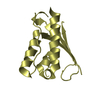
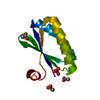


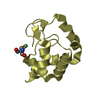
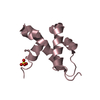

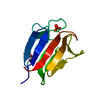
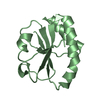
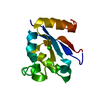
 PDBj
PDBj HSQC
HSQC